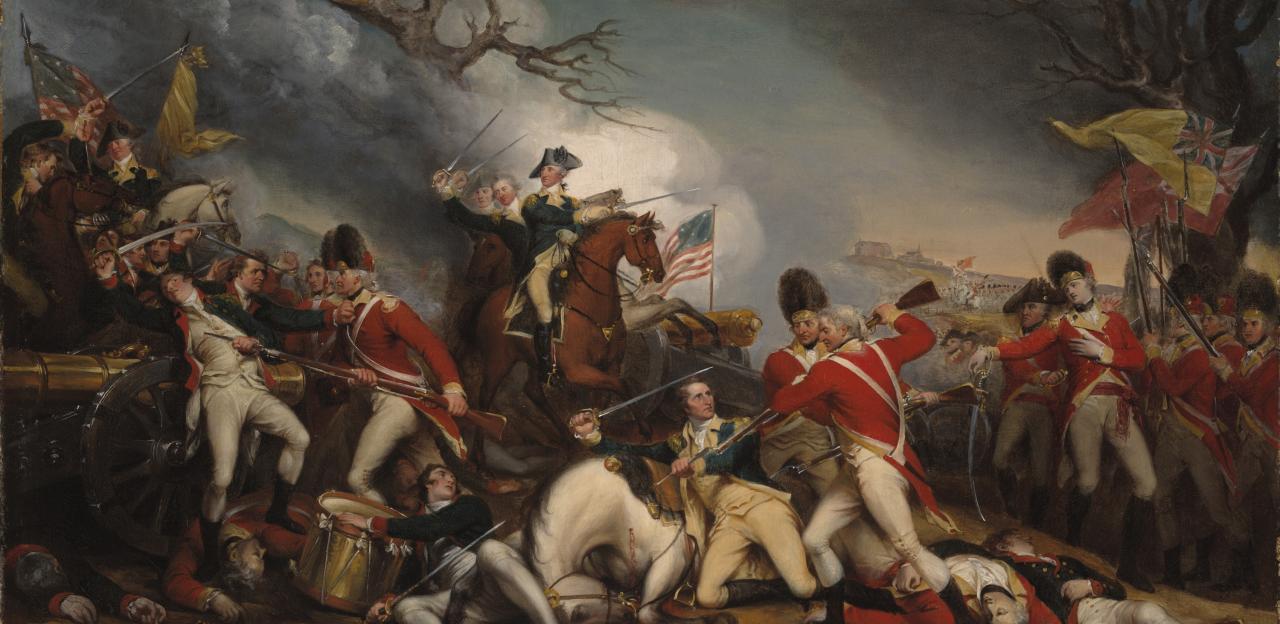Princeton

Washington was intent on following up his victory over the British army's Hessian contingent at Trenton on December 26, 1776. But time was against him. The enlistments of most of his men had expired at midnight on December 31, and it would take money, morale building and all Washington's dignity to keep them any longer.
'At this trying time,' a sergeant in his camp recalled, 'General Washington, having now but a handful of men and many of them new recruits in which he could place but little confidence, ordered our regiment to be paraded and personally addressed us, urging that we should stay a month longer. He alluded to our recent victory at Trenton, told us that our services were greatly needed, and that we could now do more for our country than we ever could at any future period, and in the most affectionate manner entreated us to stay. The drums beat for volunteers, but not a man turned out. The soldiers worn down from fatigue and privations, had their hearts fixed on home and the comforts of the domestic circle, and it was hard to forego the anticipated pleasures of the society of our dearest friends.
'The General wheeled his horse about, rode in front of the regiment, and addressing us again said, 'My brave fellows, you have done all I asked you to do and more than could be reasonably expected. But your country is at stake, your wives, your houses, and all that you hold dear.
"You have worn yourself out with fatigues and hardships, but we know not how to spare you. If you will consent to stay only one month longer, you will render that service to the cause of liberty and to your country which you probably never can do under any other circumstances. The present is emphatically the crisis which is to decide our destiny.'
'The drums beat the second time. The soldiers felt the force of the appeal. One said to another, 'I will remain if you will.'
'Others remarked, 'We cannot go home under such circumstances.'
'A few stepped forth, and their example was immediately followed by nearly all who were fit for duty in the regiment, amounting to about two hundred volunteers.'
Together with a 1,600-man Pennsylvanian brigade commanded by General Thomas Mifflin, and 600 Pennsylvania militia under Col. John Cadwalader, Washington had managed to muster about 5,200 men, though many of them were poorly trained. Cadwalader, in fact, had arrived too late to take part in the Battle of Trenton but occupied the town after Washington had pulled out. Not wishing to discourage the newly arrived reinforcements, Washington crossed the Delaware for the fourth time to join Cadwalader, then retired to the south bank of Assunpink Creek.
To the north, the overall British commander, General William Howe, remained cautious, for which his subordinates criticized him. Some might even have questioned his loyalty to King George III, as Howe understood and even sympathized with the rebel cause in the American colonies. He had opposed the Coercive Acts and at one time even declared that he would refuse an American command if it were offered to him. When the call came, however, Howe accepted, citing his duty to 'serve my country in distress,' and saying, 'A man's private feelings ought to give way to the service of the public at all times.'
Howe had granted General Charles Lord Cornwallis leave to tend to his ailing wife in England. Cornwallis was moments from boarding his ship when news of the Trenton disaster arrived, along with orders from Howe to deal with Washington's army once and for all. Journeying 50 miles through harsh weather, Cornwallis quickly organized British forces in southern New Jersey and plotted to strike back at the man who had kept him from returning home. Having left 1,400 troops at Princeton under Lt. Col. Charles Mawhood and 1,200 at Maidenhead (now Lawrenceville) under General Alexander Leslie, Cornwallis had a total of 5,500 to 6,000 Redcoats with him.
On January 1, 1777, Cornwallis led his main force toward Trenton, but his progress was delayed by a series of attacks, ambushes and fighting retreats orchestrated by rebel Col. Edward Hand.
As the sun came up on January 3, Cornwallis rose and gazed across at the enemy lines. Except there was no enemy there. The rebels were gone. While Cornwallis slept, Washington had put his own plan into action. Leaving only 400 of his men to maintain a semblance of nocturnal activity in his camp, he had withdrawn his baggage and heavy artillery, with their wheels wrapped in rags to muffle the sound, south to Burlington. At 1 a.m., the bulk of his army had departed on an audacious march around Cornwallis' force to strike at the detachment the Briton had left behind at Princeton. To cut Princeton off from reinforcements, Washington detached 350 troops under General Hugh Mercer to destroy the Stony Brook Bridge.
After leaving the 40th Regiment of Foot to garrison Princeton, Col.l Mawhood had set out with 800 soldiers of the 17th and 55th regiments to join Cornwallis at Trenton. There were 276 troops of the 17th Foot with him when he reached Stony Brook Bridge at about 8 a.m.; the rest trailed a mile behind. Mawhood had expected an unimpeded march to Trenton, but he looked back and noticed what seemed to be a patrol of between 350 and 400 men who were not his own. A moment of fear and panic set in–how did they get behind him? Quickly he turned his troops around and ordered them back across the bridge. The high ground, not Trenton, was now his primary objective.
Mercer, too, realized the hill's importance and led his men there. The race turned into a confused melee as the two forces confronted one another at Clark's Orchard. In the first exchange of gunfire, 26-year-old Capt. William Leslie, nephew of General Leslie, was struck in the left breast and side while leading a company of the 17th Foot. He died moments later in the arms of his servant, Peter MacDonald, who hastily put his body in a baggage wagon.
After several more volleys, the 17th Foot fixed bayonets. Only about 20 of Mercer's militiamen carried muskets that mounted bayonets, and most had rifles that were slower to load than smoothbore muskets. In consequence, they fell back before the intimidating British rush. 'No,' Mercer ordered. 'Forward! Forward!' A bayonet pierced his chest, then another and another. A dozen blows or more, and the general slumped down near the hill that would later bear his name.
At that point, some of Col. Cadwalader's troops came up over Orchard Hill, but the more experienced British pushed them back too, leaving bayonet-pierced bodies in their wake. A rout of the Americans seemed to be in the offing, but then their commander suddenly appeared on the scene. While General Nathanael Greene rallied and reorganized his troops, Washington advanced to within 30 yards of the British line. A round was fired, and suddenly the Redcoats loosed a full volley of musket balls. When the smoke cleared, however, still atop his fine horse was the tall, lean figure of General Washington. 'Charge!' he ordered, 'Charge them! Pull up! Pull up!'
The Patriots regrouped, and soon it was the Redcoats who fell back. Remembering the enemy bugler's call on Harlem Heights, Washington pressed forward, crying out, 'It's a fine fox hunt, boys!'
Just to the north, General John B. Sullivan was busy engaging the British 40th and 55th regiments of Foot. After successfully outflanking their defenses with two regiments of his own at Frog Hollow, he managed to push the Redcoats back toward Princeton, where they took cover in and around Nassau Hall, part of the College of New Jersey (now Princeton University). Capt. Alexander Hamilton led the firing upon the hall, which was bombarded with artillery. One cannonball tore the head off a picture of King George II. At that point, the British surrendered, and 194 Redcoats became American prisoners.
Mawhood realized that his only chance was to break through to Trenton. With bravado still admired in England to this day, the colonel led the 17th Foot in a bold charge in defiance of the numbers against him and managed to escape. Washington followed him closely for a time, capturing several more prisoners, but he knew it was only a matter of time before Cornwallis would show up with fresh Regulars. Wisely, he had his men destroy Stony Brook Bridge–and none too soon, for Cornwallis arrived just as the Continental rear guard was marching out.
In his assessment of the Battle of Princeton, Washington reported that the enemy 'in killed, wounded and prisoners must have lost near 500 men. Upwards of 100 of them were left dead in the field, and with what I have with me, and what was taken in the pursuit and carried across the Delaware, there are near 300 prisoners, 14 of which are officers, all British.' He was unable to ascertain his own casualties because of the continued pursuit, but estimated that the 'slain in the field was about 30.'
After Princeton the cause of American independence, once regarded as nothing but an ideal, became a distant but obtainable goal. The French, always ready to do whatever damage they could to the British, felt confident enough in the rebellion's prospects to send supplies to America. After news arrived of an even greater American victory at Saratoga in October 1777, the French would go further, officially recognizing the United States and committing to an alliance.
But that was yet to come. In the meantime, Washington settled his troops in Morristown for a harsh winter.
-This article was written by Ross Rosenfeld and originally published in the January/February 2005 issue of Military History magazine produced by the Weider History.


